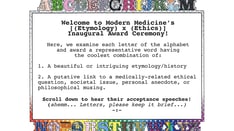This transcript has been edited for clarity.
Hi. I'm Art Caplan at the Division of Medical Ethics at New York University School of Medicine. Today, I'm talking to you from my summer home in Ridgefield, Connecticut, where it's finally, after many months of winter, turned into outdoor weather.
I'm going to talk to you today about a really interesting, quiet development in medical memorabilia. We're all familiar with the idea that people create markets in all sorts of memorabilia. Some of you may, as kids, have collected baseball cards and thought, 'Oh, if I'd only kept that collection, I'd be very wealthy today. I could have sold it to a collector." You obviously have big markets in coins, artwork, and many areas where people collect things.
Recently, Tommy John — some of you who are a little bit older may remember him as a pitcher for the Los Angeles Dodgers back in the 1970s — donated a cast from a very famous operation to the Smithsonian Museum. The operation has become known as Tommy John surgery. It basically involves transplanting a tendon to replace something damaged in the pitcher's elbow through wear and tear. You put in a new one transplanted from the other arm, or you might even use a donor tendon if one wasn't available. That reconstruction allowed Tommy John to pitch for many more years and pitch very well.
By the way, he first thought of donating his cast from this operation to the Baseball Hall of Fame, but he realized he wasn't in the Baseball Hall of Fame. Then, he and his surgeon, Frank Jobe, who pioneered this procedure as one of the world's most famous sports orthopedic surgeons, thought maybe the Smithsonian might have an interest. They did.
Out of the attic came his cast — he saved it because his Dodgers teammates had signed it after he'd had the operation — and off it went to the Smithsonian. That's good for Tommy John, and it's good for Frank Jobe, the surgeon. They sort of made history by having this really pathbreaking surgery, which many pitchers and other athletes have used since, memorialized in the Smithsonian.
I'm going to predict something else. For many more medical items — everything from scalpels to masks to images to things like tissues, say, from the first pig heart surgery — I think we're going to see a medical memorabilia market explode. We've already seen this with college athletes using their image and likeness to endorse products or to say, this is the basketball that I used at the University of Connecticut when we won our women's championship, or this is a piece of the floor from the NCAA finals, or whatever it might be. There are many markets in sports stuff, not just physical objects, but even images.
Similarly, there are many people investing not in works of art but in memes, meaning images that are put up as unique opportunities to invest on the Internet and you kind of own the original image. I think we're going to see the same thing happen in medicine. I think people are going to say, you know what, if you donate money to our medical center or our medical school, we'll give you the first whatever it is from the first pioneering surgery that was done here, or we have available images of a very exciting 100th anniversary operation done for the first time in our practice. There are many opportunities locally, nationally, and internationally that I think are going to go out there.
They will raise some ethics questions about whether that is exploiting patients. Are you taking advantage of their being involved in medical care to make money on the resale of images, tissues, casts, or other pieces of medical equipment as we saw in the Tommy John situation? Let me be clear, though, by reminding you that Tommy John donated his cast.
What I'm forecasting is in a market. It's basically saying that things that weren't seen as very valuable or were never explored as having value, just as we see in athletics, college and pro, we're going to see enter into medicine. Be careful before you throw away that mask or before you destroy something as medical waste. It may have value. It may be something you could sell. It may be something your school, your practice, or your institution suddenly wants to convert into something valuable.
I'm Art Caplan at the Division of Medical Ethics at NYU School of Medicine. Thanks for watching.
Arthur L. Caplan, PhD, is director of the Division of Medical Ethics at New York University Langone Medical Center and School of Medicine. He is the author or editor of 35 books and 750 peer-reviewed articles as well as a frequent commentator in the media on bioethical issues.
Follow Medscape on Facebook, Twitter, Instagram, and YouTube
Medscape Business of Medicine © 2022 WebMD, LLC
Any views expressed above are the author's own and do not necessarily reflect the views of WebMD or Medscape.
Cite this: Arthur L. Caplan. Items From Famous Surgeries or Injuries Soon Selling as Memorabilia? - Medscape - Jul 05, 2022.








Comments